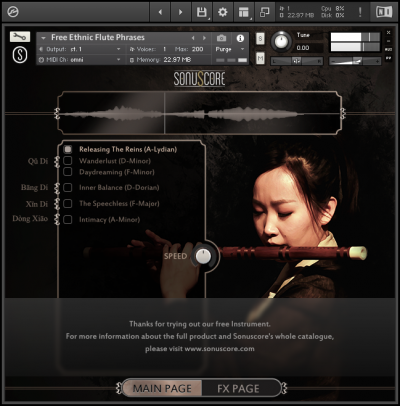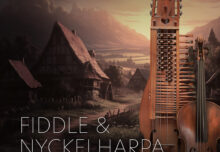NEW RELEASE
CELESTIAL HARP
For many people who grew up playing video games, their first experience really listening and taking pleasure in harp music may have been from the Legend of Zelda games, where the Celtic harp played a prominent role in Koji Kondo’s soundtracks. The Legend of Zelda games are now considered as having been one of the biggest influences on game music, setting the sound for fantasy soundtracks across the board. From A Link to the Past and Ocarina of Time to the latest Breath of the Wild, Kondo’s, and later Eric Bucholz’s, scores served to not only advance the in-game playing experience, but also to define the fantasy soundtrack genre itself.
It’s two instruments that really stand out in the series: the ocarina and the Celtic harp. It’s with that fantastic, nostalgic thrill that we have for those classic fantasy video games and movies that we approached our opportunity to do the Celtic Harp.

CELTIC VS. CONCERT HARPS
With HA•PI, we had already covered the Concert Harp. It serves a more prominent role in classical music. But the Celtic Harp is more what you would have heard in medieval taverns, Irish pubs, and Elven forests rather than the grand, imperial opera halls of the Baroque era. The Celtic harp has a softer tone than the Concert Harp, and is far smaller and more portable. It’s sound gives the listener a greater sense of magic and enchantment – which is why it was used in the Legend of Zelda soundtracks and in Howard Shore’s Lord of the Rings soundtrack and just about any other fantasy film that’s been produced.
“The CELESTIAL HARP is a Celtic cut,” project lead Matthias Meeh explains. “It’s much shorter and has a different sound quality to it. I think when composers look for more of an Elvish or fairytale harp, they would rather use a Celtic Harp instead of a normal one.”
It was in a random conversation that Matthias discovered someone at Sonuscore had a Celtic Harp, and the idea was immediately born to bring it into the GLOW family as a sister to our Concert Harp, HA•PI.
CAPTURING THE SOUND
Matthias approached the project with his usual meticulous attention to detail, carefully recording every aspect of the harp’s sound. The team used the same microphones as they did for HA•PI to keep the sound in the same family.
“The main mic is a Brauner Phantera, which is a really nice microphone,” Matthias said. “It has a very warm character in the mix. The recording room was a bit special because it’s normally used by sound designers, so it’s pretty dry and has no reverb… afterwards I used an impulse response to reverberate the whole thing and make it feel like it’s in a room. [The advantage of using an impulse response is] the harp has some nice sound qualities that you can control. It has no bad resonances or anything, and I’m actually quite liking this style of recording.
“Normally in studio recordings, you always have some floor noise, but because this room is so sterile, it was very easy to remove the noise without removing harmonic signals. It’s pretty easy to make a noise profile when it’s so dry.”
One challenge Matthias met during the recording process was that the higher the strings go, the shorter they are, so naturally you must pluck harder to get an even volume. “I think this is a big challenge in recording a harp, to have the velocity retained like that,” says Matthias. “For the harpists’ perspective, I think this is common knowledge, but if you’re just loading it up as a composer and you don’t think about it, you’d end up wondering why it gets harsher and harsher the higher you get.” But we figured out how to compensate for that.

HARP HARMONICS
They captured five round robins and three velocity layers for the Harmonics layer and four for the regular one. The Harmonics layer captures the flageolet style of playing on harp. “Whenever you play a string,” Matthias explains, “it resonates and has a [fundamental] tone and overtones, so when you pluck a string, it will also resonate not only in the base frequency, but an octave higher and higher and higher. So, for example, when you distort guitar tones, it sounds so great because you clip them at some point. The wave gets square-y and the overtones start to shine. Like with power chords, it sounds so cool distorted because the more harmonics you have, the worse the sound gets when it’s clipped, but with power chords you only have two notes, and you have a full wall of sound out of just those two notes.
“So when you’re playing flageolets, you are basically muting the main frequency, the root, so that only the overtones come through. It’s like a picking technique where you are picking and immediately after, you mute the string, but for some reason the overtones still remain.”

ALL IN THE FAMILY
Though we departed from the traditional GLOW naming method of four letters split by a dot, CELESTIAL HARP is still very much a GLOW instrument. It is a single, lightweight instrument and has all the same features as the other GLOW instruments, mainly meaning the GLOW slider that turns the natural sound into a shimmering, ethereal pad.
With the GLOW slider, when you hold down a chord, “it emits random round robins, random velocities, and random octave ups and downs,” Matthias explains. “It won’t trigger different notes, but if I’m pressing C and G, for example, it will trigger all the Cs and Gs and preferably at lower velocities. And it even can start mid-sample sometimes.”
“The GLOW instruments are very intuitive and small, and very easy to get a cool, complex sound without taking too much brain space, so you don’t have this choice paralysis that you can have with bigger products,” Matthias continues. “If you need an easy harp that sounds good on its own without any other special things, you can just load it up and it won’t take too much RAM or memory space in your project. It’s also great if you need an easy ambient pad or atmosphere.”
DESIGNING THE PRESETS
In creating the presets, Matthias tried to bring out both the natural qualities and the ambient pads. “I always go for one or two classic sounds when I’m designing presets,” Matthias says. “I think most people want something without fancy reverb or anything, just something natural sounding. And when I have those basic ones that probably most people would use, I start getting creative and use all the possibilities the instrument has to offer to make some sounds that I enjoy.”
That’s when he really taps into the true power of the GLOW engine. For his own preference, he likes to use the GLOW series instruments for the power that the slider offers, and he shows that in his presets as well. “I turn my GLOW slider up, add some delay and reverb and then it goes on the background of my music to fill out the spaces. So I deliver two or three of those over-the-top presets as well.
“So basically 2-3 bread and butter presets and the rest more ambient.”
FINAL THOUGHTS
If you’re looking for an expressive instrument that’s perfect for both folk and ambient music, CELESTIAL HARP is definitely your go-to. With its beautiful tone and the GLOW slider that sends the sound to space and beyond, it’s a tool that will be sure to spark your creativity.
“I think some composers will use CELESTIAL HARP as a pad that’s not a synth,” Matthias says, “but has a realistic or natural sounding quality to it. And those who want to use a Celtic Harp will also like this.”
CELESTIAL HARP is available at a normal price of $49.00 / 49.00€ and during the first two weeks of release, at an intro price of $39.00 / 39.00€, so get it now and save! For more info, check out the product page.
Available for the full version of Kontakt 6.7.1 or higher.
Take advantage of our 20% off intro pricing while you can!









